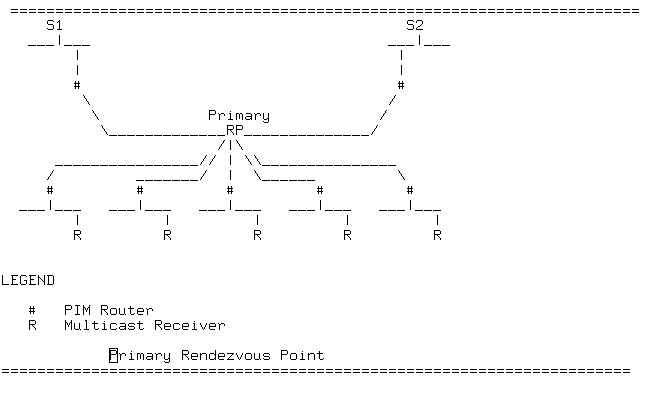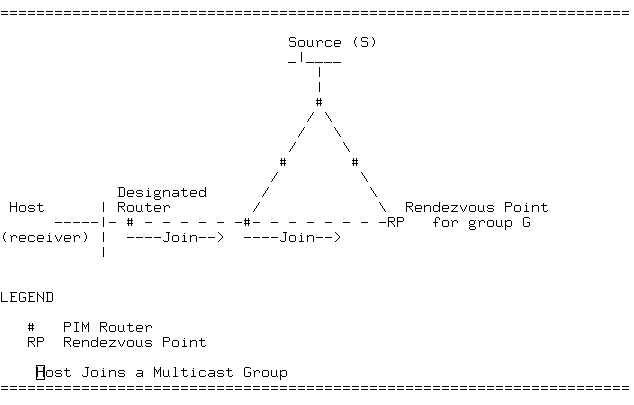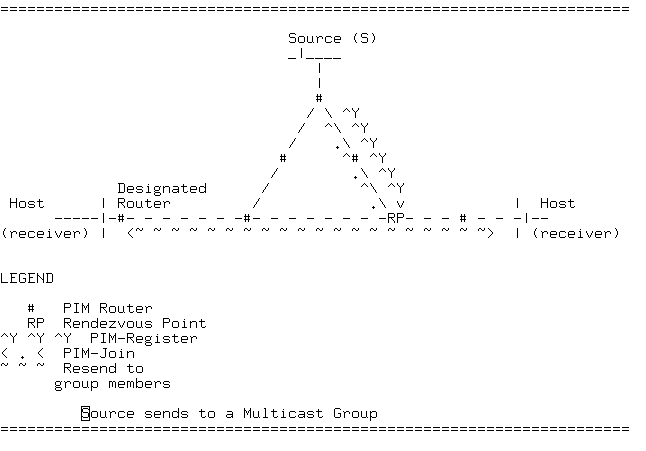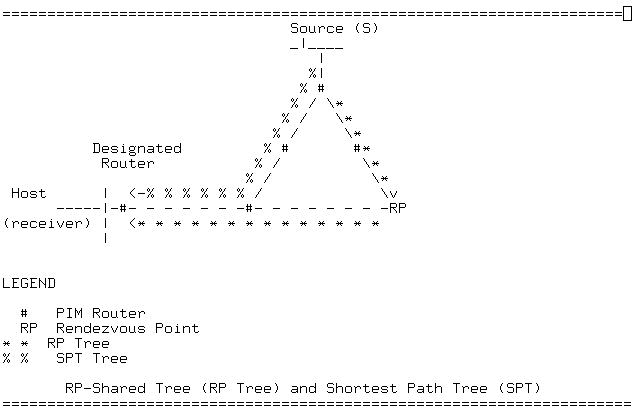
The Protocol Independent Multicast (PIM) routing protocol is currently under development by the Inter-Domain Multicast Routing (IDMR) working group of the IETF. The objective of the IDMR working group is to develop a standard multicast routing protocol that can provide scalable inter-domain multicast routing across the Internet.
PIM receives its name because it is not dependent on the mechanisms provided by any particular unicast routing protocol. However, any implementation supporting PIM requires the presence of a unicast routing protocol to provide routing table information and to adapt to topology changes.
PIM makes a clear distinction between a multicast routing protocol that is designed for dense environments and one that is designed for sparse environments. Dense-mode refers to a protocol that is designed to operate in an environment where group members are relatively densely packed and bandwidth is plentiful. Sparse-mode refers to a protocol that is optimized for environments where group members are distributed across many regions of the Internet and bandwidth is not necessarily widely available. It is important to note that sparse-mode does not imply that the group has a few members, just that they are widely dispersed across the Internet.
The designers of PIM argue that DVMRP and MOSPF were developed for environments where group members are densely distributed. They emphasize that when group members and senders are sparsely distributed across a wide area, DVMRP and MOSPF do not provide the most efficient multicast delivery service. DVMRP periodically sends multicast packets over many links that do not lead to group members, while MOSPF sends group membership information over many links that do not lead to senders or receivers.
While the PIM architecture was driven by the need to provide scalable sparse-mode delivery trees, it also defines a new dense- mode protocol instead of relying on existing dense-mode protocols such as DVMRP and MOSPF. It is envisioned that PIM-DM will be deployed in resource rich environments, such as a campus LAN where group membership is relatively dense and bandwidth is likely to be readily available.
PIM-Dense Mode (PIM-DM) is similar to DVMRP in that it employs the Reverse Path Multicasting (RPM) algorithm. However, there are several important differences between PIM-DM and DVMRP:
- PIM-DM relies on the presence of an existing unicast routing protocol to adapt to topology changes, but it is independent of the mechanisms of the specific unicast routing protocol. In contrast, DVMRP contains an integrated routing protocol that makes use of its own RIP-like exchanges to compute the required unicast routing information. MOSPF uses the information contained in the OSPF link state database, but MOSPF is specific to only the OSPF unicast routing protocol.
- Unlike DVMRP which calculates a set of child interfaces for each (source, group) pair, PIM-DM simply forwards multicast traffic on all downstream interfaces until explicit prune messages are received. PIM-DM is willing to accept packet duplication to eliminate routing protocol dependencies and to avoid the overhead involved in building the parent/child database.
For those cases where group members suddenly appear on a pruned branch of the distribution tree, PIM-DM, like DVMRP, employs graft messages to add the previously pruned branch to the delivery tree. Finally, PIM-DM control message processing and data packet forwarding is integrated with PIM-Sparse Mode operation so that a single router can run different modes for different groups.
PIM-Sparse Mode (PIM-SM) is being developed to provide a multicast routing protocol that provides efficient communication between members of sparsely distributed groups - the type of groups that are most common in wide-area internetworks. Its designers believe that several hosts wishing to participate in a multicast conference do not justify flooding the entire internetwork with periodic multicast traffic. They fear that existing multicast routing protocols will experience scaling problems if several thousand small conferences are in progress, creating large amounts of aggregate traffic that would potentially saturate most wide-area Internet connections. To eliminate these potential scaling issues, PIM-SM is designed to limit multicast traffic so that only those routers interested in receiving traffic for a particular group "see" it.
PIM-SM differs from existing dense-mode multicast algorithms in two essential ways:
- Routers with directly attached or downstream members are required to join a sparse mode distribution tree by transmitting explicit join messages. If a router does not become part of the pre-defined distribution tree, it will not receive multicast traffic addressed to the group. In contrast, dense-mode multicast routing protocols assume downstream group membership and continue to forward multicast traffic on downstream links until explicit prune messages are received. The default forwarding action of the other dense-mode multicast routing protocols is to forward traffic, while the default action of a sparse-mode multicast routing protocol is block traffic unless it is explicitly requested.

- PIM-SM is similar to the Core Based Tree (CBT) approach in that it employs the concept of a rendezvous point (RP) where receivers "meet" new sources. The initiator of each multicast group selects a primary RP and a small ordered set of alternative RPs, known as the RP-list. For each multicast group, there is only a single active RP. Each receiver wishing to join a multicast group contacts its directly attached router which in turn joins the multicast distribution tree by sending an explicit join message to the group's primary RP. A source uses the RP to announce its presence and to find a path to members that have joined the group. This model requires sparse mode routers to maintain some state (i.e., the RP-list) prior to the arrival of data packets. In contrast, dense mode multicast routing protocols are data driven since they do not define state for a multicast group until the first data packet arrives.
When there is more than one PIM router connected to a multi- access LAN, the router with the highest IP address is selected to function as the Designated Router (DR) for the LAN. The DR is responsible for the transmission of IGMP Host Query messages, for sending Join/Prune messages towards the RP, and for maintaining the status of the active RP for local senders to multicast groups.
To facilitate the differentiation between DM and SM groups, a part of the Class D multicast address space is being reserved for use by SM groups. When the DR receives an IGMP Report message for a new group, the DR determines if the group is RP-based or not by examining the group address. If the address indicates a SM group, the DR performs a look up in the associated group's RP-list to determine the primary RP for the group. The draft specification describes a procedure for the selection of the primary RP and the use of alternate RPs if the primary RP becomes unreachable.


